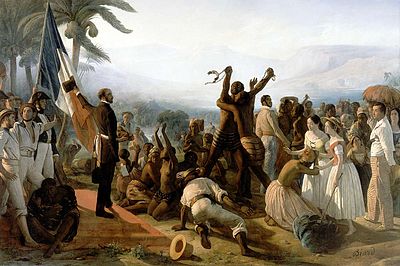
Search
Timeline of abolition of slavery and serfdom

The abolition of slavery occurred at different times in different countries. It frequently occurred sequentially in more than one stage – for example, as abolition of the trade in slaves in a specific country, and then as abolition of slavery throughout empires. Each step was usually the result of a separate law or action. This timeline shows abolition laws or actions listed chronologically. It also covers the abolition of serfdom.
Although slavery of non-prisoners is technically illegal in all countries today, the practice continues in many locations around the world, primarily in Africa, Asia, and Eastern Europe, often with government support.
Ancient times
During classical antiquity, several prominent societies in Europe and the ancient Near East regulated enslavement for debt and the related but distinct practice of debt bondage (in which a creditor could extract compulsory labor from a debtor in repayment of their debt, but the debtor was not formally enslaved and was not subject to all the conditions of chattel slavery, such as being perpetually owned, sellable on the open market, or stripped of kinship).
Reforms listed below such as the laws of Solon in Athens, the Lex Poetelia Papiria in Republican Rome, or rules set forth in the Hebrew Bible in the Book of Deuteronomy generally regulated the supply of slaves and debt-servants by forbidding or regulating the bondage of certain privileged groups (thus, the Roman reforms protected Roman citizens, the Athenian reforms protected Athenian citizens, and the rules in Deuteronomy guaranteed freedom to a Hebrew after a fixed duration of servitude), but none abolished slavery, and even what protections were instituted did not apply to foreigners or noncitizen subjects.
Medieval times
- N.B.: Many of the listed reforms were reversed over succeeding centuries.
1500–1700
1701–1799
1800–1829
1830–1849
1850–1899
1900–1949
1950–1999
2000–present
See also
- Abolitionism
- History of slavery
- List of abolitionist forerunners (by Thomas Clarkson)
- Reparations for slavery
- Slave Trade Acts
- Sexual slavery
- Slavery at common law
- Slavery in modern Africa
- Slavery in the 21st century
- Timeline of the civil rights movement
Notes
References
Further reading
- Campbell, Gwyn. The Structure of Slavery in Indian Ocean Africa and Asia (Frank Cass, 2004)
- Davis, David Brion. Inhuman Bondage: The Rise and Fall of Slavery in the New World (2008) excerpt
- Drescher, Seymour. Abolition: A History of Slavery and Antislavery (Cambridge University Press, 2009)
- Drescher, Seymour. Pathways from slavery: British and colonial mobilizations in global perspective (Routledge, 2018).
- Drescher, Seymour. "Civil Society and Paths to Abolition." Journal of Global Slavery 1.1 (2016): 44–71.
- Finkelman, Paul, and Joseph Miller, eds. Macmillan Encyclopedia of World Slavery (2 vol 1998)
- Finkelman, Paul, and Seymour Drescher. "The eternal problem of slavery in international law: Killing the vampire of human culture." Michigan State Law Review (2017): 755+ online Archived 24 January 2021 at the Wayback Machine.
- Gordon, M. Slavery in the Arab World (1989)
- Grindal, Peter. Opposing the Slavers; The Royal Navy's Campaign against the Atlantic Slave Trade (L.B. Tauris 2016) ISBN 978-1-78831-286-8
- Hinks, Peter, and John McKivigan, eds. Encyclopedia of Antislavery and Abolition (2 vol. 2007) 795pp; ISBN 978-0-313-33142-8
- Lovejoy, Paul. Transformations in Slavery: A History of Slavery in Africa (Cambridge UP, 1983)
- Mathews, Nathaniel. "The 'Fused Horizon' of Abolitionism and Islam: Historicism, the Quran and the Global History of Abolition." Journal of global slavery 4.2 (2019): 226–265.
- Morgan, Kenneth. Slavery and the British Empire: From Africa to America (2008)
- Rodriguez, Junius P., ed. The Historical Encyclopedia of World Slavery (1997)
- Rodriguez, Junius P., ed. Encyclopedia of Emancipation and Abolition in the Transatlantic World (2007)
- Sinha, Manisha. "The Problem of Abolition in the Age of Capitalism The Problem of Slavery in the Age of Revolution, 1770–1823, by David Brion Davis." American Historical Review 124.1 (2019): 144–163.
External links
- Timeline – What happened before 1807? The Royal Naval Museum
- Timeline – What happened after 1807? The Royal Naval Museum
- Slavery and Abolition The National Archives
- American Abolitionists and Antislavery Activists, comprehensive list of abolitionist and anti-slavery activists and organizations in the United States, including US and international anti-slavery timelines.
Text submitted to CC-BY-SA license. Source: Timeline of abolition of slavery and serfdom by Wikipedia (Historical)
Articles connexes
- Slavery Abolition Act 1833
- End of slavery in the United States
- End of slavery in France
- Slavery in Russia
- Slavery in Brunei
- Slavery in Poland
- History of sexual slavery in the United States
- Abolitionism
- Black Rednecks and White Liberals
- History of slavery
- Slavery in Zanzibar
- Slavery in Libya
- Slavery in Malaysia
- Slavery in France
- Slavery in Britain
- List of last survivors of American slavery
- Slavery in Indonesia
- Islamic views on concubinage
- Emancipation reform of 1861
- John S. Jacobs
Owlapps.net - since 2012 - Les chouettes applications du hibou


